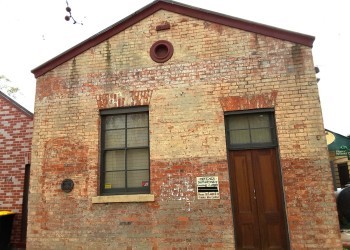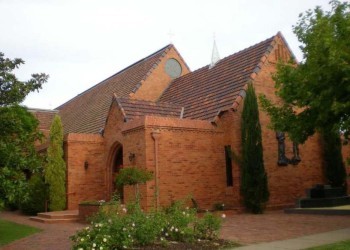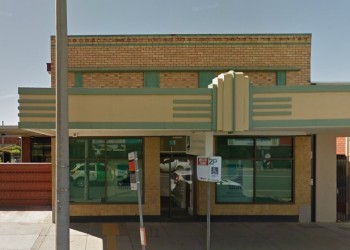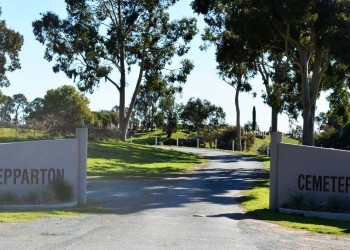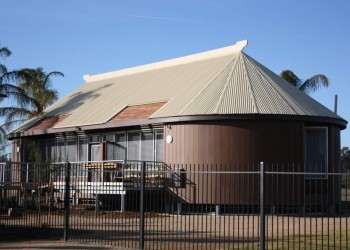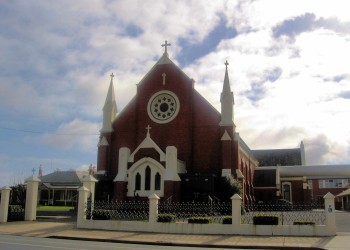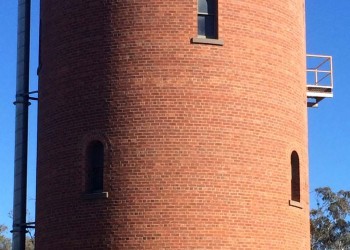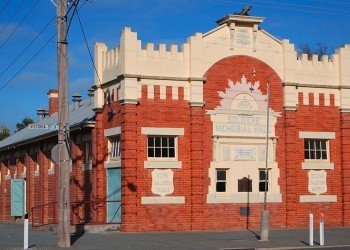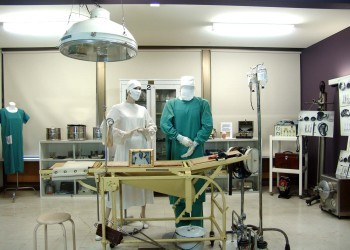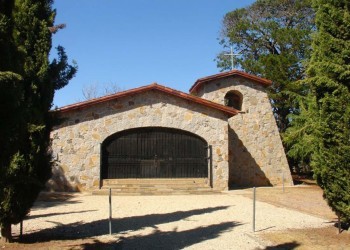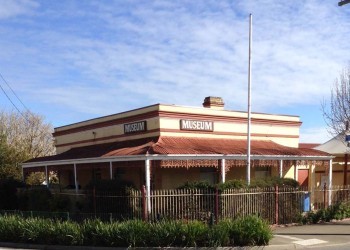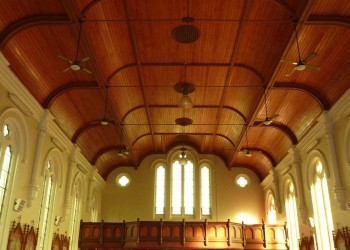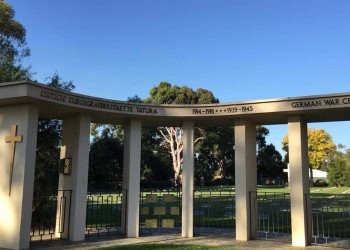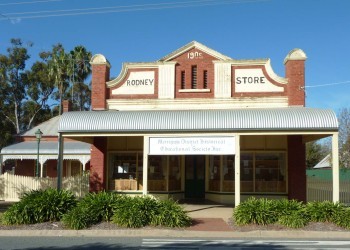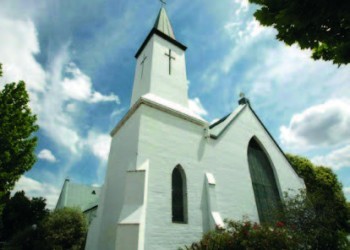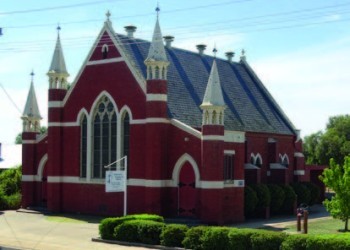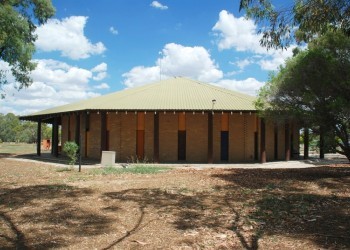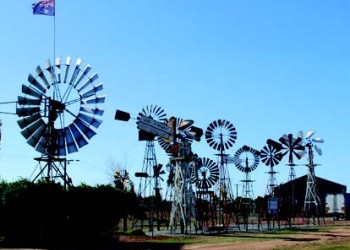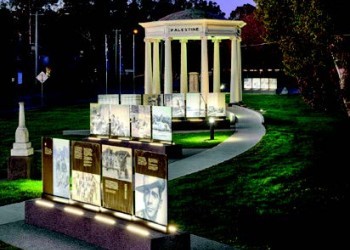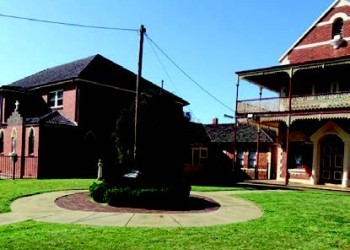While we strive for accuracy, unintentional errors may occur. Please refer to the original English version for official content.
Independent Visiting
Many venues are opening their doors for visitors to attend independently. All Museums are admission-free on Fri 29 & Sat 30 November 2024 upon presentation of this web page.
Shepparton Heritage Centre (Foresters’ Hall)
Shepparton’s oldest building, constructed as the first public hall by William Fraser in 1873. Used for many different purposes, e.g. Foresters’ Lodge (1933). Many absorbing exhibits: see the Post Office clock! Various publications for sale.
Open: Fri, Sat 10.30am – 4pm

The Big Hymn Sing at St Mel’s (Christ The King Catholic Church)
Both tangible and intangible heritage! The 1908 ‘amphitheatre–style’ church, with accomplished local musician Graeme Brewer at the historic 1951 Fincham pipe organ, will host a grand session of hymn-singing. All welcome! Join with other choristers and enjoy singing beloved Hymns. Please pre-book your personal favourite Hymns by texting the name or first line to 0400 947 547. Organist extraordinaire Graeme Brewer will be playing the St Mel’s instrument and singing led by Shirley Ferguson.
Open: Sat 1.30pm

St Augustine’s Anglican Church, Shepparton
Louis Williams, a renowned church architect, designed this 1926 church with his particular twentieth century adaptation of Gothic and his usual emphasis on quality and craftsmanship. Note the beautiful features of the interior.
Open: Sat 10am – 12pm

Former Mechanics’ Institute, Shepparton
Originally the Shepparton Free Library and Workingmen’s Club (1884); the Public Library replaced the billiard room in the 1950s. The cream brick Moderne façade dates to the 1940s, with extensive later remodelling completed by 2005. Cath Gale to conduct tour.
Open for Tour: Sat 2pm – 3pm

Shepparton General Cemetery
Learn about this fascinating and picturesque cemetery, dating from 1874, with expert Jeanette Doherty, author of the recent history of the cemetery. The range of burial options reflects our multicultural society.
Tour: Sat 11am
 (with your assistant) Some rough terrain.
(with your assistant) Some rough terrain. Philippine House Museum and Library, Shepparton
The Philippine House, portraying a typical (if idealised) Philippine home, was constructed in 1988 as part of the International Village. Restored in 2015, it houses Philippine history and artefacts, and hosts community activities.
Open: Sat 10am – 12pm

St Brendan’s Catholic Church, Shepparton
Designed by renowned local architect JAK Clarke in 1900, St Brendan’s was renovated and enlarged to the design of high profile and prolific Catholic architect AA Fritsch in 1923-24, with later alterations and additions.
Open: Sat 12pm – 1pm

Brick Water Tower, Shepparton
The 1889 brick tower, no longer needed and minus its tall wrought iron tank, is an iconic local landmark being preserved by GV Water for its regionally significant heritage value.
Open: Fri 10am - 2pm and 1pm - 3pm

St Mel’s (Christ The King Catholic Church)
Shepparton’s second Catholic parish erected this distinctive futuristic church, by Trieste-born architect Ermin Smrekar, in 1970. It catered to the influx of Italian migrants as Shepparton expanded. The spaciousness of the interior is striking.
Open: Sat 10.30am – 12.30pm. Tour: 10.30am

Tallygaroopna Soldiers Memorial Hall
This proud little 1924 Memorial hall, topped by its trophy WW1 German trench mortar, retains many interesting artefacts. At £2500, it cost the small community £1000 more than Shepparton’s famous statue. See the RSL ‘dugout’.
Open: Sat 12 noon – 4pm

Dookie Public Cemetery
Situated on the western slopes of Mt Major, with panoramic views providing a striking backdrop to the graves. It is one of two cemeteries in the Dookie area, with burials dating from the 1870’s.
Guide available: Sat 11am – 1pm
 (no made paths)
(no made paths)Mooroopna Historical Society Museum and Gallery
A huge and varied collection relating to Mooroopna’s history is attractively displayed throughout the former Grutzner House. The sometimes gruesome medical collection, the largest in country Victoria, relates particularly to the Mooroopna Hospital.
Open: Fri 12 noon – 3pm

Mooroopna Cemetery
This fine cemetery, with its stately avenue of cotton palms, includes 19th century graves of ethnic Chinese and the unmarked graves of 937 persons of many nationalities who died between 1881 and 1944 in the Mooroopna Base Hospital.
Guide available: Sat 10am – 12noon
 (few made paths)
(few made paths)Murchison Heritage Centre
The award-winning Heritage Centre collects and preserves Murchison’s history. Informative displays cover the Aboriginal Protectorate, Day’s Mill, Camp 13 and much more. See sporting memorabilia, and part of the famous Murchison meteorite!
Open: Sat 10am – 4pm

Murchison Anglican Church
This charming red brick Gothic country church of 1884 contains high quality memorial windows by two well-known Melbourne firms of glass manufacturers, Brooks Robinson and W Montgomery.
Open: Sat 10 am – 12 pm

Murchison Cemetery and Ossario
The Ossario was built 1961. It is an open sanctuary built of stone, roofed with Roman tiles and is the final resting place of 131 Italian POW’s and Internees who died in Australia during WW 2.
Guided Tour with John Gribben: Fri 10am, 11am, 1pm
 (no made paths)
(no made paths)Tatura Wartime Camps And Irrigation Museum
The fascinating WW2 internment and POW camps collection is of State heritage significance. Irrigation is the other focus: from the original four-roomed building (c.1888) the irrigation scheme for the western Goulburn Valley was developed. Listed on the Victorian Heritage Register.
 Open: Fri & Sat 1pm – 3pm
Open: Fri & Sat 1pm – 3pmVictory Hall (1925) and Mechanics’ Institute (1880, 1893), Tatura
Explore the twin halls, reinvigorated and restored by concerted local effort, which now enrich the Tatura streetscape and again provide a social and cultural focal point. Hear about their history from those who saved them.
Open: Fri 10am – 12 noon

Sacred Heart Catholic Church And St Mary’s Hall, Tatura
This imposing group of church, convent, and the former St Mary’s school, on a prominent site in the town, reflects Tatura’s strong Catholic allegiances. The detailed Romanesque (round-arched) exterior is complemented by the beautiful interior.
Open: Fri 11am – 12pm

Tatura German War Cemetery
Situated on the northern section of Tatura General Cemetery. Created in 1958, it contains the remains of 250 Germans who died in Australia during WW1 and WW2, 11 of whom were POW. Their remains were brought from other cemeteries throughout Australia and reinterred here.
Open: Fri 11am – 12 pm. At 11am Judy Forster will walk and talk through the cemetery.

Merrigum Museum, formerly Judd’s General Store
One of the most extensive collections in the municipality; includes agricultural machinery and household items. The Judd family conducted their general store here for 66 years. A rare original early 20th century shop front.
Open: Fri 12 noon – 3pm

Shepparton Uniting Church, Former Scots’ Church
The centre of Presbyterianism in Shepparton until denominational union in 1977, Scots’ Church was built in stages from 1888, with the signature bell tower by prominent Melbourne architects John and Phyllis Murphy added in 1964-65.
Open: Sat. Tour/talk: 10am-1pm.

St Andrew’s Presbyterian Church, Tatura
Prolific ecclesiastical architect Alec Eggleston designed this substantial church for Tatura’s Presbyterians in 1912, Rodney Shire engineer A Knee (snr) locally supervising some of the construction details. The earlier 1883 church adjoins the Mance.
Open: Fri 11am – 1pm

Bangerang Cultural Centre, Shepparton
Designed by prominent Australian architect Frederick Romberg and opened in 1982 as part of the International Village, the Centre houses an important collection of Indigenous cultural items from the local area and beyond. Listed on the Victorian Heritage Register
Open: Fri 11am – 12pm

Shepparton Family History Group
Wondered about your family’s history? Curious about that family rumour? Come and see how the SFHG and its wide range of resources can help you with genealogical research, and how some of the unknowns in your family’s past might become clear. You may even have information to contribute on your ancestors!
Open: Fri, Sat 10am-4pm

St Mary’s Catholic Church, Dookie
Very popular for weddings due to its picturesque rural setting outside Dookie, on land donated by vineyard owner John Curtain, this impressive cruciform (cross-shaped) 1898 church is a prominent local landmark. The presbytery is the municipality’s only Catholic monastery.
Open: Sat 11am – 12pm

Shepparton Art Museum (SAM) – Stories from the SAM Collection
Visit the People’s Gallery on level 2 and hear from the Gallery Curator, the history of early gallery acquisitions. Of these, two magnificent portraits by Sir John Longstaff are featured. When the collection was commenced in 1936 Sir John, a former resident of Shepparton was invited to advise on proposed gallery purchases.
Curator’s talk: Fri 2:30pm

Cook’s Windmills, Shepparton East
A collection of 14 windmills from the surrounding district as far as Jerilderie, Conargo and Nathalia. Set up by the late Mr. Theo Cook to retain a valuable record of the innovativeness of early settlers who relied on wind-power to meet their water needs.
Guide: Ray Cook. Sat 11am – 12pm

Mooroopna Cenotaph
The original cenotaph was dedicated on April 25th 1928 and has now been refurbished to include the Digi Glass pictorials which recognises the various conflicts since WW 1, These were constructed in 2021.
Meet Historian Les Young: Sat 10am – 11am

Tatura Convent
The current building was constructed in 1941, the home of the Sisters of Mercy who operated the St Mary’s College. The adjoining St Mary’s Hall was built in 1901 and housed boarders until 1952. The Sisters of Mercy Nuns vacated the Convent in the mid 1980’s and in 2019 this building was transformed into the Sandhurst Catholic Education offices. Join Alex who will lead you through the convent’s 83 years of history and change.
Open: Sat 11am – 1pm



